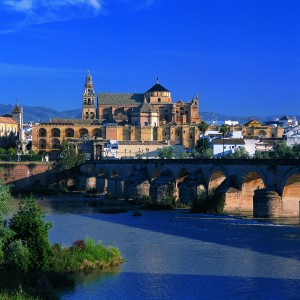This year the Spanish Tourism Office is promoting the fact that Spain is the world’s nation with the second most designated World Heritage Sites. The Spanish World Heritage Cities Group is the association constituted by these 13 monumental cities: Alcalá de Henares, Avila, Cáceres, Cordoba, Cuenca, Ibiza, Merida, Salamanca, San Cristóbal de la Laguna, Santiago de Compostela, Segovia, Tarragona and Toledo.
Being more than just a single monument, each of these cities is full of important landmarks that have been declared by UNESCO to be of international interest. In some cases it is specifically the old town that has been declared a World Heritage Site.

Alcalá de Henares
This town near Madrid is the birthplace of the illustrious Miguel de Cervantes, author of ‘Don Quixote’, and home to one of the most prestigious universities in Spain. Its rich monumental heritage, formed by churches, convents and university buildings, gives a glimpse of life in Castilia during the Spanish Golden Age.
Ávila
The most important sight in Ávila, an hour outside of Madrid, is the spectacular city wall, among the best preserved (and maintained) in Europe, perhaps the world. The old town centre is also full of attractive churches and other buildings. These other sights are best seen from the wall itself, which can be walked along for a small fee.
Cáceres
More than 10 towers dominate the historic quarter of Caceres, delimited by Arab walls. Cobbled streets marked by medieval, fortified homes and Renaissance palaces make up the most beautiful sceneries in this city. The local history is closely related to one the historic, peninsular routes: ‘Vía de la Plata’ (the Silver Route), a Roman road that linked Seville and Astorga, used by the pilgrims who were headed to Santiago de Compostela.
Cordoba
Cordoba is situated in the interior of Andalusia where past and modernity blend in together. This thousand-year-old city is a living legacy of the different cultures that settled here throughout its history. If you walk round the old quarter you will discover a beautiful network of alleyways, squares and white-washed courtyards surrounding the Great Mosque-Cathedral, which reflects the importance of the city in the Middle Ages, and is the symbol of the city.
Cuenca
Half way between Madrid and Valencia, in the Region of Castile-La Mancha, between the Júcar and Huécar river canyons, this city is recognised for its wealth of monuments. Its historic centre looks out over rocky canyon walls in the heart of the Cuenca Mountains. The Cathedral, Casas Colgadas (Hanging Houses) and cobbled streets charm the most hardened tourist.
Ibiza
Ibiza provides an excellent example of the interaction between the marine and coastal ecosystems. The island preserves considerable evidence of its long history through its archaeological sites and fortifications.
Merida
Located in the path of the Silver Route, or Vía de la Plata, Mérida is heir to a magnificent Roman legacy. The theatre, the Amphitheatre and the Temple of Diana make this city – the ancient capital of Roman Lusitania – one of the best preserved archaeological sites in Spain.
Salamanca
Home to one of the oldest universities in Europe, two cathedrals, a number of interesting churches and the grandest Plaza Mayor (Main Square) in all of Spain. Most of the city is built from local yellow sandstone that gives the city a unique colour.
San Cristóbal de La Laguna
San Cristóbal de La Laguna, the former capital of Tenerife, is an historic Canary Islands city with a long university tradition. Its model colonial layout, awarded World Heritage status, contains several of the island’s major religious buildings, including the Cathedral, as well as a multitude of ancestral homes from the 17th and 18th centuries.
Santiago de Compostela
Discover Santiago de Compostela, the capital of the Region of Galicia. Thousands of people from all over the world come to this city every year, many of them reaching the end of the Way of Saint James pilgrimage route through its historic centre to the Cathedral Saint James.
Segovia
Easily accessible from Madrid, in Segovia, the old quarter of which, along with its Roman aqueduct, are World Heritage Sites, lies on high ground between the Eresma and Clamores Rivers. In addition to its famous aqueduct – still standing after nearly 2,000 years, despite no mortar used in its construction, numerous Romanesque churches, the Cathedral and Fortress go to form this magnificent landscape that presides over this part of Castile. Its modern Parador Hotel is one of the best places for the visitor to savour the city’s most traditional dish: roast suckling pig.
Tarragona
On the shores of the Mediterranean, right on the Costa Daurada, former Roman Tarraco offers us an important legacy of monuments amid extensive beaches. Its archaeological remains form one of the points of interest of this Catalan city. From here you can make countless trips, like the one that brings visitors to get to know one of the best preserved Cistercian monasteries, which is also a World Heritage Site: the monastery of Poblet.
Toledo
Just an hour from Madrid, Toledo is one of the Spanish cities with the greatest wealth of monuments. Known as the ‘city of the three cultures’, because Christians, Arabs and Jews lived together there for centuries, behind its walls Toledo preserves an artistic and cultural legacy in the form of churches, palaces, fortresses, mosques and synagogues. This great diversity of artistic styles makes the old quarter of the capital of Castile – La Mancha a real open-air museum.


